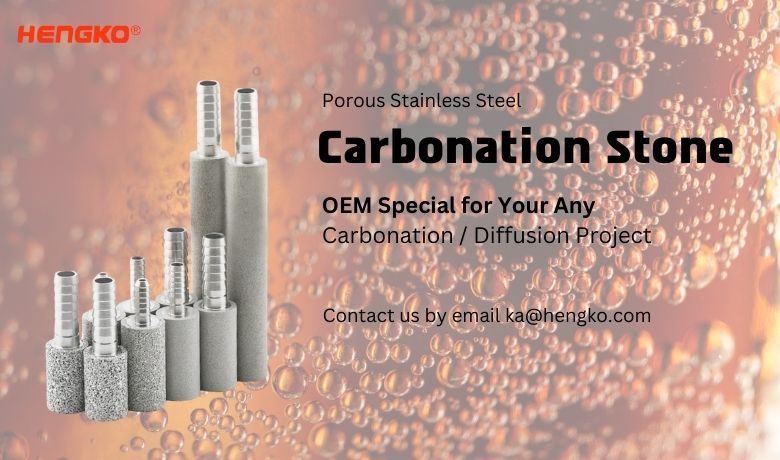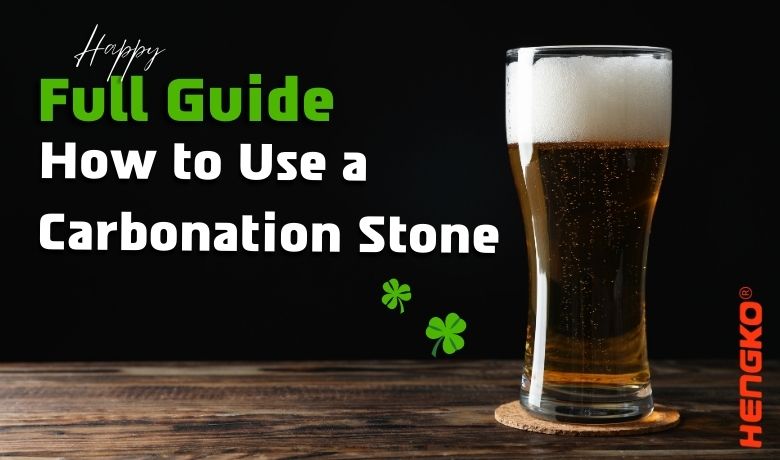
If you’re a fan of carbonated beverages, you know that getting perfect carbonation can be a challenge. However, by using a carbonation stone, you can achieve consistent and high-quality carbonation every time. In this guide, we’ll take you through the steps you need to follow to use a carbonation stone properly, including choosing the right stone, preparing it for use, carbonating your beverage, and maintaining and storing your stone.
Introduction
Carbonated beverages are a popular choice for many people, but getting the perfect level of carbonation can be difficult. Fortunately, using a carbonation stone can help you achieve consistent and high-quality results every time. In this guide, we’ll take you through some steps you need to follow to use a carbonation stone properly, including choosing the right stone, preparing it for use, carbonating your beverage, and maintaining and storing your stone.
What is a carbonation stone?
In Short, A carbonation stone also named Diffusion Stone that is a small and porous stone that is used to infuse a liquid with carbon dioxide. It is typically made of stainless steel or ceramic and is designed to be attached to a pressurized system.
Why use a carbonation stone?
A carbonation stone allows for precise and consistent carbonation, which is important in the production of carbonated beverages. It ensures that the carbon dioxide is evenly dispersed throughout the liquid, resulting in a better tasting and more visually appealing beverage.
Who needs a carbonation stone?
A carbonation stone is essential for anyone who wants to produce carbonated beverages at home, as well as for those who work in the food and beverage industry.
How to Choose a Carbonation Stone ?
When choosing a carbonation stone, there are a few factors you should consider:
1. Types of carbonation stones
There are two main types of carbonation stones: inline and diffusion stones. Inline stones are designed to be used directly in the flow of liquid, while diffusion stones are placed in a separate chamber and used to carbonate the liquid through diffusion.
2. Materials
Carbonation stones can be made from a variety of materials, including stainless steel, ceramic, and sintered stone. Stainless steel is the most common material, as it is durable and easy to clean.
3. Size
The size of your carbonation stone will depend on the size of your system and the amount of liquid you are carbonating. Larger stones are typically used for larger systems and higher volumes of liquid.
4. Price range
Carbonation stones can vary in price, depending on the size, material, and quality. While higher-end stones may be more expensive, they are often more durable and produce better results.
Preparation
Before using your carbonation stone, you need to prepare it properly:
1. Cleaning your carbonation stone
It’s important to clean your carbonation stone thoroughly before use to remove any debris or contaminants. You can use a cleaning solution specifically designed for carbonation stones or a mixture of water and vinegar.
2. Sanitizing your carbonation stone
Once your stone is clean, you need to sanitize it to ensure that it is free of any harmful bacteria. You can use a sanitizing solution or boil your stone in water for a few minutes.
3. Connecting your carbonation stone to your system
Once your stone is clean and sanitized, you can connect it to your pressurized system. Make sure that the stone is securely attached and that there are no leaks.
4. Carbonating Your Beverage
Once your carbonation stone is connected to your system, you’re ready to carbonate your beverage:
5. Temperature control
The temperature of your liquid can affect the carbonation process, so it’s important to keep it within a certain range. Typically, a temperature of around 40°F (4°C) is ideal for carbonating beverages.
6. Pressure control
The pressure of your system will depend on the type of beverage you are carbonating and the desired level of carbonation. It’s important to monitor the pressure and adjust it as needed to achieve the desired results.
7. Time considerations
The amount of time it takes to carbonate your beverage will depend on the size of your system and the level of carbonation you are trying to achieve. Typically, it can take anywhere from a few minutes to a few hours.

For HENGKO, Till Now We Main Supply and Manufacture 316L Stainless Steel carbonation stone ,
Because There some Many Special Features as follow:
Features of stainless steel carbonation stones:
1. Ability to withstand high pressure and temperatures
2. Resistance to corrosion
3. Non-reactivity with acidic or alkaline liquids
4. Ease of cleaning and sanitizing
5. Do not impart any unwanted flavors or odors on the beverage being carbonated
Let me know if you need any further information.
Troubleshooting
If you’re having trouble carbonating your beverage, there are a few things you can try. Check for leaks, adjust the pressure or temperature, or make sure that your stone is clean and properly connected.
1. Maintenance and Storage
To ensure the longevity of your carbonation stone, it’s important to maintain and store it properly:
2. Proper cleaning and storage
After each use, you should clean your carbonation stone thoroughly and store it in a dry, cool place. This will help prevent bacteria from growing and extend the life of your stone.
3. Common issues and how to fix them
If you’re experiencing issues with your carbonation stone, such as clogging or poor carbonation, there are a few things you can try to fix the problem. Check for clogs or debris, adjust the pressure or temperature, or replace the stone if necessary.
4. Replacing your carbonation stone
Over time, your carbonation stone may become worn or damaged, which can affect its performance. If this happens, you should replace your stone to ensure consistent and high-quality carbonation.
Application of carbonation stones
So for the Application for the carbonation stone, we list some main applications. please check as follow:
1. Beer carbonation: To carbonate beer, attach the carbonation stone to your pressurized system and connect it to your keg. Set the pressure and temperature to the desired levels, and let the beer carbonate for several hours to several days, depending on the style and level of carbonation you are looking for.
2. Soda carbonation: To carbonate soda, attach the carbonation stone to your pressurized system and connect it to your soda bottle. Set the pressure and temperature to the desired levels, and let the soda carbonate for several minutes to several hours, depending on the level of carbonation you are looking for.
3. Wine carbonation: To carbonate wine, attach the carbonation stone to your pressurized system and connect it to your wine bottle. Set the pressure and temperature to the desired levels, and let the wine carbonate for several hours to several days, depending on the style and level of carbonation you are looking for.
4. Sparkling water: To carbonate water, attach the carbonation stone to your pressurized system and connect it to your water container. Set the pressure and temperature to the desired levels, and let the water carbonate for several minutes to several hours, depending on the level of carbonation you are looking for.
5. Cider carbonation: To carbonate cider, attach the carbonation stone to your pressurized system and connect it to your cider container. Set the pressure and temperature to the desired levels, and let the cider carbonate for several hours to several days, depending on the style and level of carbonation you are looking for.
6. Kombucha carbonation: To carbonate kombucha, attach the carbonation stone to your pressurized system and connect it to your kombucha container. Set the pressure and temperature to the desired levels, and let the kombucha carbonate for several hours to several days, depending on the level of carbonation you are looking for.
7. Seltzer water: To make seltzer water, attach the carbonation stone to your pressurized system and connect it to your water container. Set the pressure and temperature to the desired levels, and let the water carbonate for several minutes to several hours, depending on the level of carbonation you are looking for.
Remember to adjust the pressure and temperature as needed to achieve the desired results, and be sure to clean and sanitize your carbonation stone properly to ensure consistent and high-quality carbonation.
Do you know some other applications, or you have other special project need to use our stainless Carbonation Stone,
you are welcome to check our products page or send us enquiry by email ka@hengko.com to OEM your special Carbonation Stone.
Conclusion
By following the steps outlined in this guide, you’ll be able to master the art of using a carbonation stone and enjoy perfectly carbonated beverages every time. Whether you’re a homebrewer or a professional in the food and beverage industry, a carbonation stone is an essential tool for achieving consistent and high-quality results.
Now that you know how to use a carbonation stone, it’s time to get started!
Whether you’re a homebrewer or a professional in the food and beverage industry, using a carbonation stone is an essential tool for achieving consistent and high-quality results.
So why wait? Start exploring the world of carbonated beverages today!
If you have any further questions or need additional information, feel free to check out the resources and further reading included in this guide. And as always, happy brewing!
Media Contact
Company Name: HENGKO
Contact Person: Media Relations
Email: Send Email
Phone: 0086-755-88823250
Country: China
Website: https://www.hengko.com/

